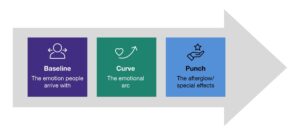We Need To Shift How We Think About Emotion And Journeys
Emotion Is The Key To Benchmarking Journeys
We know customer journeys matter. We know emotion matters. It’s time to bring these two together and use journeys to design for the full scope of emotion. To know what good looks like — and to benchmark customer journeys — we need to understand how to design for emotion. It impacts customers, and it impacts your bottom line:
- Emotion is the primary driver of customer loyalty. Forrester’s Customer Experience Index (CX Index™) research shows that emotion is the strongest predictor of customer experience outcomes such as customer loyalty.
- Emotion accounts for nearly half of a brand’s energy. Brand energy gets charged by emotion, salience, and fit — overwhelmingly, emotion forms the most important pillar.
- The functional aspects of the experience are emotional, too. For customers on journeys as varied as buying pet food, signing up for a streaming service, buying home furnishings, or buying a home, two of the top considerations when purchasing are price and fit.
Shift How You Think About Emotion And Journeys
- First, we need to go beyond just equating emotion with delight and create experiences that maintain an optimal ratio of positive to negative emotions to shape memory. A great experience maintains an optimal ratio of positive to negative emotions that shapes memory. To maintain an optimal ratio of positive to negative emotions, we need to understand the emotional makeup of journeys.
- Second, we need to understand the emotional makeup of journeys — the baseline, curve, and punch. The baseline is the emotion people arrive with. The curve is the emotional arc of the journey. The punch is the story we tell ourselves (and others), the scripts we write to make sense of the experience we had.

Evolve Journey Mapping, Measurement, And Design
Go back to your journey maps and journey data visualizations to zoom in on what the customer is seeing and doing and look at your journeys through the lens of emotion and the baseline, curve, and punch. This framework will help you evolve journey mapping, measurement, and design:
- Baseline: Redesign the start of your experiences based on your customer’s emotion. If you are designing for a high-anxiety journey like buying a home, make sure to reassure the customer early on. Use checklists and be clear about what the customer can expect to relieve anxiety. Do not jump the gun when it comes to calls to action in the first stages of the journey. If you are designing for a high-confidence journey like a pet-food buying journey, cut to the chase about things like features and packaging size.
- Curve: Fine-tune the most memorable and impactful moments. Pay attention to the functional things that drive emotion. If your customers’ experiences are mostly neutral and devoid of peaks, seek to arouse states such as wonder, pride, and — yes — even delight. Look for the make-or-break moment that is derailing your journey and monitor whether your tolerable lows remain tolerable. Fine-tune memory-making moments that you control.
- Punch: Assess when the punch really happens — it’s probably later than you imagine. The punch is the proof in the pudding. The end of an experience can make up for the peak’s shortcomings or undermine its positive effects, depending on how it’s handled. And remember that most journeys are ongoing, so think carefully about opportunities to reengage customers.
Companies that go the extra mile to understand the baseline, curve, and punch of key journeys and apply those learnings broadly across the organization will pull ahead of the competition and drive true differentiation.
You can learn more about my research here. If you have a good example to share (baseline, curve, and punch) please schedule a briefing and tell me all about it. If you’re a Forrester client and want to discuss, please schedule an inquiry.
